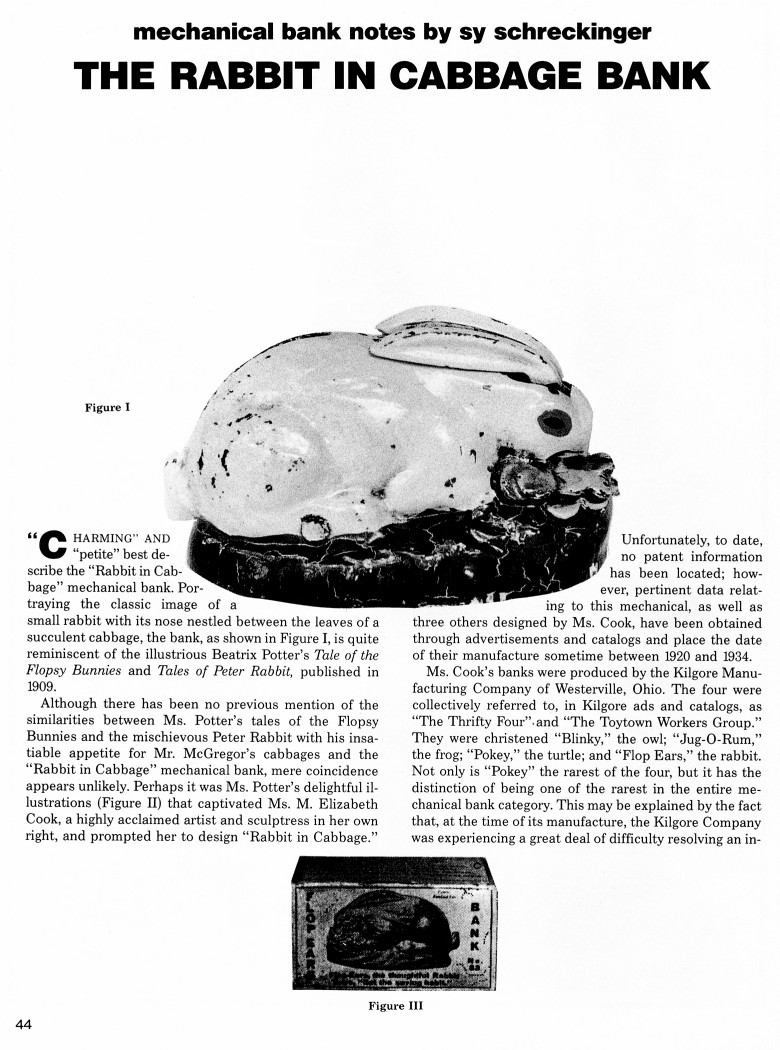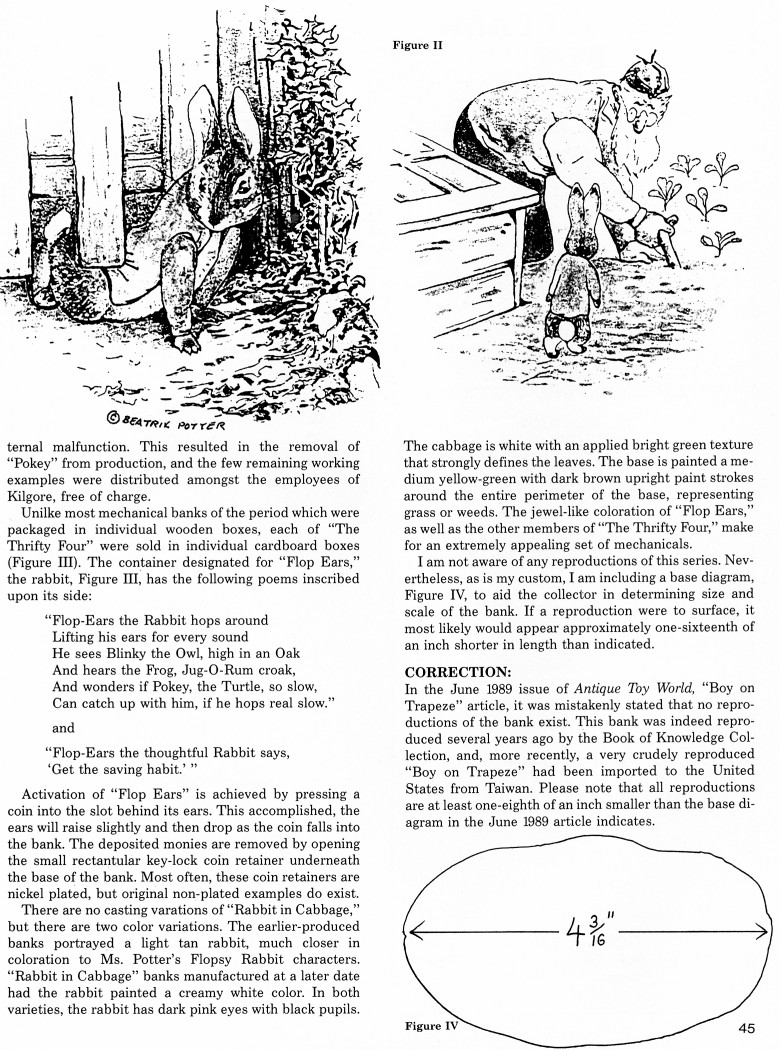|
The Rabbit in Cabbage Bank
by Sy Schreckinger – ANTIQUE TOY WORLD Magazine – May, 1990
“Charming” and “petite” best describe the
"Rabbit in Cabbage" mechanical bank. Portraying the classic image of a
small rabbit with its nose nestled between the leaves of succulent
cabbage, the bank as shown in Figure I, is quite reminiscent of the
illustrious Beatrix Potter's Tale of the Flopsy Bunnies and Tales of Peter
Rabbit, published in 1909.
Although there has been no previous mention of the similarities
between Ms. Potter's tales of the Flopsy Bunnies and the mischievous Peter
Rabbit with his insatiable appetite for Mr. McGregor's cabbages and the
"Rabbit in Cabbage" mechanical bank, mere coincidence appears unlikely.
Perhaps it was Ms. Potter's delightful illustrations (Figure II) that
captivated Ms. M. Elizabeth Cook, a highly acclaimed artist and sculptress
in her own right, and prompted her to design "Rabbit in Cabbage."
Unfortunately, to date, no patent information has been located;
however, pertinent data relating to this mechanical, as well as three
others designed by Ms. Cook, have been obtained through advertisements and
catalogs and place the date of their manufacture sometime between 1920 and
1934.
Ms. Cook's banks were produced by the Kilgore Manufacturing Company
of Westerville, Ohio. The four were collectively referred to, in Kilgore
ads and catalogs, as "The Thrifty Four". and "The Toytown Workers Group."
They were christened "Blinky," the owl; "Jug-O-Rum," the frog; "Pokey,"
the turtle; and "Flop Ears," the rabbit. Not only is "Pokey" the rarest of
the four, but it has the distinction of being one of the rarest in the
entire mechanical bank category. This may be explained by the fact that,
at the time of its manufacture, the Kilgore Company was experiencing a
great deal of difficulty resolving an internal malfunction. This resulted
in the removal of "Pokey" from production, and the few remaining working
examples were distributed amongst the employees of Kilgore, free of
charge.
Unlike most mechanical banks of the period which were packaged in
individual wooden boxes, each of "The Thrifty Four" were sold in
individual cardboard boxes (Figure III). The container designated for
"Flop Ears," the rabbit, Figure III, has the following poems inscribed
upon its side:
"Flop-Ears the Rabbit hops around
Lifting his ears for every sound
He sees Blinky the Owl, high in an Oak
And hears the Frog, Jug-O-Rum croak,
And wonders if Pokey, the Turtle, so slow,
Can catch up with him, if he hops real slow."
and
"Flop-Ears the thoughtful Rabbit says,
'Get the saving habit.' "
Activation of "Flop Ears" is achieved by pressing a coin into the
slot behind its ears. This accomplished, the ears will raise slightly and
then drop as the coin falls into the bank. The deposited monies are
removed by opening the small rectangular key-lock coin retainer underneath
the base of the bank. Most often, these coin retainers are nickel plated,
but original non-plated examples do exist.
There are no casting variations of "Rabbit in Cabbage," but there are
two color variations. The earlier-produced banks portrayed a light tan
rabbit, much closer in coloration to Ms. Potter's Flopsy Rabbit
characters. "Rabbit in Cabbage" banks manufactured at a later date had the
rabbit painted a creamy white color. In both varieties, the rabbit has
dark pink eyes with black pupils. The cabbage is white with an applied
bright green texture that strongly defines the leaves. The base is painted
a medium yellow-green with dark brown upright paint strokes around the
entire perimeter of the base, representing grass or weeds. The jewel-like
coloration of "Flop Ears," as well as the other members of "The Thrifty
Four," make for an extremely appealing set of mechanicals.
I am not aware of any reproductions of this series. Nevertheless, as
is my custom, I am including a base diagram, Figure IV, to aid the
collector in determining size and scale of the bank. If a reproduction
were to surface, it most likely would appear approximately one-sixteenth
of an inch shorter in length than indicated.
CORRECTION: In the
June 1989 issue of Antique Toy World, "Boy on Trapeze"
article, it was mistakenly stated that no reproductions of the bank exist.
This bank was indeed reproduced several years ago by the Book of Knowledge
Collection, and, more recently, a very crudely reproduced "Boy on Trapeze"
had been imported to the United States from Taiwan. Please note that all
reproductions are at least one-eighth of an inch smaller than the base
diagram in the June 1989 article indicates.
|


